Over the weekend I had the good fortune to “sit down” over email with Vinay Gupta, the creator of the amazing Hexayurt project that we highlighted last week.
The Naib: Before we get started could you tell us a little about yourself.
Vinay Gupta: My name is Vinay Gupta, and I invented the Hexayurt. I run what is essentially an open source design project around solving the problems of the word’s poor by bringing the cost of essential services down to a level they can comfortably afford.
I took a roundabout path to get here: I started out doing 3D graphics. In college, I helped start a company called Voxar that did medical imaging software. I had the critical insight that the entire enterprise was based on – that some throw away demo software Andrew Bissell (the founder) had written was actually the key to a whole new way of rendering. I spend about the next six years doing 3D graphics off and on, as well as a stint trying to start a Geodesic Dome company called WorldView LivingSpace with David Kinne, an incredibly talented Quality guru who taught me about Permaculture , Deming and the whole culture of quality. That left a deep imprint. WorldView had licensed a really superior dome technology from
Wil Fidroeff and I’m still surprised that Wil’s dome tech hasn’t taken over the world!
Most 3D graphics is all about triangle meshes and that’s the tie in to buildings – geodesics are very strong because of the way triangles hold forces, and fitting triangles correctly to a sphere is the core of Buckminster Fuller’s dome geometry.
1. The Naib: How did the hexayurt project get started and who else is involved in the project?
Vinay Gupta: The hexayurt had two genesis points. The first was my curiosity about how to overcome the bane of geodesic domes – not that they leak, but that the weird angles and unusual component sizes fit so poorly to standard building materials, often creating up to 40% waste. So I was playing around with 4′ x 8′ sheets in my head, trying to find a way to build domes with them, and I stumbled on the hexayurt’s basic shape: six isosceles triangles with the same base and height form a cone suitable for a roof. It’s “geodesic-like” – no longer do all the points fit on the surface of a sphere, but on the other hand, you can cut it by eye in the field with a stick and still get a building.
So that was Genesis 1. Genesis 2 was the Sustainable Settlements CharretteThis was one of those epochal meetings that RMI throws every so often where they rewrite reality by figuring out better ways of doing things. I was not at the Charrette but I was working at RMI off and on as a volunteer at the time and got a good dose of the ideas and insights, including the key insight that there needed to be a building that could be moved with the population when they were sent home, rather than being tied to the refugee camp. It all came together from there, really. Amory Lovins notions about autonomous building provided the last leg of the triangle. Over the next few years I began to assemble the system.
There are also three groups involved: the first is me and my immediate collaborators – Lindsey Darby, Woody Evans and a few other folks.
The second is the vendors: the Hexacomb cardboard manufacturers, the wood gasification stove engineers and so on.
The third group is the aid agencies and especially the US Department of Defense. I attended Strong Angel and since then the building and concepts associated have come into contact with a lot of people, particularly since a rather senior fellow by the name of Dr. Linton Wells rather likes the design (he’s a big fan of Amory Lovins work and the design is a direct extension of Amory’s thinking to a very large degree.) It was a bit surprising at first to be in such tight collaboration with those guys but they are the final resort – they’re the people the world turns to when things go really, really wrong like they did in the tsunami or the Pakistan earthquake, so they’re very much on the look out for better answers to “how do we keep these folks alive?”
2. The Naib: What are the main goals of the project, and who do you hope to help with your yurt?
Vinay Gupta:My goal is pretty simple: by the time I die, everybody in the world has a place to sleep and a bowl of rice a day. No starvation, no poverty of the kind that forces men and women to live like beasts of the field. We can do it: we are well past the point that Buckminster Fuller said our technology had to pass before it was possible.
Most people envisage making the poor rich: this is a social and economic approach. The rich fight it like hell all over the world.
So instead, I decided to focus on cutting the price of essential goods and services to the point where the poor can afford them. Nobody seems to be against that, and if we all agree, then the work will go so much faster than if I had to waste effort arguing with people who don’t think what I’m doing is a good idea.
“Cheap housing for the poor? Any objections? OK, let’s GO.”
Now, “the poor” is not a homogeneous group. Right now, the limits on my reach are $1 per day: less than that and you aren’t enough of a part of a market economy to be able to afford anything and that’s going to break product-based approaches to poverty alleviation. Similarly, past about $10 per day, who wants to live in a hexayurt? So the target group is threefold:
- The refugees and others who have their housing bought for them – we’ll make the aid dollar go a lot further than it would otherwise!
- Villagers, denizens of slums and shanty towns, and other people who can buy their own housing if it is cheap enough and might like to upgrade from a cardboard box to a nice cabin if the price was right.
- Various ideologically motivated groups who want to break free of the system as it currently stands and return to the agrarian lifestyle. Hippies, in other words. Also some kinds of libertarians – if you want to start an island nation from scratch and you can provide no centralized infrastructure at all and still have a functioning city state or town at least…
3. TN: Wow that’s no simple goal! Like they say if you aim for the moon even if you miss you land among the stars. Speaking of sparkly things that’s a shiny looking yurt, can you tell us what it is made of, and why you picked the materials you did for the construction.
VG:That’s Tuff-R. It’s an off-the-shelf insulating board. $15 a sheet at Home Depot. It’s useful for demo buildings, Burning Man and other short use structures. For semi-permanent (20+ year) buildings, we would use its more durable sibling Thermax HD.
Both of these products are basically an inch or more of very tough styrofoam-like insulation covered with aluminum. The thickness of the aluminum changes depending on the application, and can be up to about a millimeter thick.
The other material we like is hexacomb cardboard, which is used in the packaging industry and elsewhere, and used to be used to build houses in the 1980s. They made structural insulated panels out of it. Fabulous stuff.
As for why these materials: they’re high performance and cheaper than you’d dream. Hexacomb cardboard is about ten dollars a sheet, or five if you assemble the panels yourself. Thermax HD is about thirty dollars a sheet, but that’s for something that will stand in the outdoors for many, many years and is, to all intents and purposes, a wall.
Now, why the silver? It’s a whole systems thinking thing: you reflect off as much of the energy as possible to cut the cooling costs of the building. The insulation helps cushion temperature fluctuations even further, but the reflective surface is really what does most of the work.
4. TN: What makes this yurt better than say a tent?
VG:It’s not better, it’s just good at different things. You can’t put a hexayurt in a car boot (yet.)
The main advantages, though, are:
- insulated, so you can effectively control interior temperature
- walls are psychologically much more comforting than flapping nylon
- UV light will rot a tent to bits in only a year or two where a hexayurt with advanced materials and maintenance could last indefinitely
- Mass produced, in the cardboard edition, it’s half the price or less of tents.
Also, the building itself isn’t really the big news. The infrastructure package is where the real story is here.
5.TN: The Infrsatructure package does look very interesting. Solar water sanitation, solar lighting, composting toilet and stove, can you tell us how they are integrated into the yurt and what benefit they bring to the project?
VG:Take 100,000 hexayurts and an open field. Ship no infrastructure and you have an immediate problem: open sewers contaminating any local water supplies you have. People start dying in groups within days. It’s dark at night so you have isolation and crime and everything which can be torn up and burned to warm people and cook food is gone in hours. No good: I wouldn’t ask a dog to live that way.
So now run this again with the infrastructure package: the solar water pasteurizers provide sterile drinking water from any potable-but-unclean source. Taste and chemical profile can be improved using the charcoal taken from the stoves (undocumented because I haven’t done this myself yet, but it should work.) The stoves themselves provide 3KW of heat – same as a big gas stove burner – off a fistful of wood per run. The electrical lighting system is one panel per 40ish households, and provides electrical light via LED or CCFL flashlights and area lights (like those little CF lanterns – cheap and efficient.)
Now this? This is rustic conditions, but people aren’t dying or spending 18 hours a day searching for firewood.
I could live this way, and I intend to: first chance I get with some funding and a place, and I’m moving into a hexayurt for six months to two years to really refine the details of the lifestyle and, perhaps, start work on the farming system.
6.TN: You raise an interesting point, just how long can people live in these yurts, could they serve as replacements for the urban poor?
VG: You know the old test to see if you were poor enough to qualify for a Grameen Bank loan? If the place you slept had a roof, you were too rich to qualify.
So, for the very poor, this is a huge upgrade, and I would assume they would live in them as long as they could afford to, but were not rich enough to upgrade to something even better. For the urban poor I think this is an excellent upgrade from a plywood shack.
7.TN: Could you give us an example of how the yurts would be used, lets say there is an earthquake how are the yurts deployed, and how would they be set up?
VG: Nobody knows for sure what the optimal approach to distribution and siting is. We could see an orthodox UN type approach with nice big regimented camps. We could also see a more organic approach with trucks of yurts driving through the affected areas just dropping units in people’s back gardens for them to assemble while they rebuild their houses – an option which is opened up because of the infrastructure package.
8.TN: Have these yurts been field tested during any actually disasters yet?
VG: Not yet. The design only got any real attention in 2006 – it had been a “sleeper” until then.
9.TN: Have any large NGO’s shown interest in the project?
VG: Hexayurts are doctrinally incompatible with the “use local materials” school of rebuilding, and the “don’t make the refugees too comfortable” school of government, so many NGOS won’t even really give the system a second look, although they might take the stoves or the power infrastructure ideas and run with them.
However, these views aren’t universally held by all groups so I’ve had extremely favorable reactions from the American Red Cross and some other groups, as well as the DOD tie in mentioned above.
But this is really stopgap. The real show begins when some Chinese cardboard box company sees the buildings, does the math, figures out they can make them for $90 a unit and sells three million in the next five years, making a fortune and opening the floodgates to massive international competition.
Charity is limited in a way that supply and demand is not, and vise versa. But we’re definitely hoping that the free market does the heavy lifting here, not the NGOs or governments.
10.TN: These are pretty sweet, if I wanted to get my own how would I go about doing that?
VG:
Well, there’s no commercial availability. I have the business skills of a rubber duck and know it. That’s why the design is online: you read the web site, you watch the (slow, boring, complete) videos, you make a cardboard model, freak out about how easy it seems, then make a real one, and freak out even harder.
“Wait, that was easy.” If you go to Flickr and search for Hexayurts, you’ll see a fair number of people who build their own Stretch Hexayurt from the plans on the internet. Several of these buildings are much nicer than mine because they were made with real artistry!
TN: Is there anything else about the project that you feel was not covered above?
VG: Well, first up, send money :-)
No, really, I’ve been working on this thing for a long, long time and it’s been impossible to get paid for the most part. I’m about to return to writing video games or some such occupation because my financial resources are extremely limited, and that’s a big loss. This thing deserves to be front burner and it’s just not.
And that’s really a tragedy. Everybody who’s looked at this thing in detail has been like “Oh my god, this is going to change the world.”
“Great. Can [your group/agency/government] find me some resources to finish the job?”
“Er….”
And this is where we are today: sitting on top of a set of solutions which have the capacity to utterly transform the life of every poor person on the planet, all under open licenses (apart from the off-the-shelf stuff like the stove or solar panels), ready to roll… and parked on the runway.
I think that with six months of funded development – say $100,000 – I could get all the engineering and productization done. Pay the stove guys for a revision of their system based around our needs (larger fuel handling, mainly.) Get a professional engineer to compute wind loads, heating and cooling numbers. Get 3M to do a custom tape for us with exactly the right mix of properties for real world use, rather than cobbling together two tapes, one for the structural strength, and the other to protect the first tape from UV. Actually get a really good low cost composting toilet designed and sourced, ready to buy.
We could actually take complete systems out to villages, and let them try it for as long as those units last, and gather real data on the process.
I mean, it looks good now, and it is good now. But you can imagine if this is what it’s looked like as something that got done nights and weekends by somebody with no money at all, what would it look like with a serious development push? We have a revolution to start here, people!
This needs a Branson, or a Gates, or an awful lot of small doners who want to see something happen. I won’t incorporate as a non-profit because a Board of Directors would become my lords and masters, and far too many non-profit innovators have lost their direction in the face of a Board. So it’s just me, and whatever allies I can find, and companies I hire to do design work, plus what helpers there are inside of the governments and agencies of the world.
I think, from what I’ve seen so far, that calcification may have gone too far for these groups to be able to effectively translate this technological breakout into effective action. I could be wrong about this – the US Marine Core, for example, has got serious cred in my book for the speed with which they comprehended the importance of the system and began to think about how to apply it in their work. But all I hear from people in government is strategies for negotiating with the red tape and structural problems – almost no energy turns into actual solutions work.
So I think that this thing is going to have to be done in the person to person arena: individuals and businesses.
Tell your friends in the developing world. Tell your friends in China. Tell your friends who are entrepreneurs. Spread the word everywhere and let’s shake the global tree, and find the people who have the other pieces of the puzzle that it will take to make this a global success story: how the people of the Internet rose up and struck down the worst parts of global poverty.
It’s not that there’s nothing you can do: you can help form the network of connections that it will take to move this project forward. You can help find the funding, the engineers, the product designers, the artists, the video crew, all of it. Work the networks.
The “big win” is one of these three things:
- Private capital to fund further development, with no IP lock ever possible because I will only work under open licenses.
- A company that could manufacture hexayurts on a for-profit basis, either for domestic use (think the next generation of North Face tents for extreme situations!) or, better still, a small company in Brazil or China or India that would like to expand its offerings. Some areas, like the lighting solution, are begging to be tried as microenterprises.
- A role in an NGO, university, or a government that has the capacity to fund me and my associates to finish this thing.
I don’t think I’m being too bold in saying that this is a historic development: housing cheap enough for nearly everybody to be able to afford, and decentralized services that provide for immediate human needs for about $20 per head at large scales and not much more on a village scale.
But this is only the beginning. I have to do serious work on farming, on the final rev. of the composting toilets, on the training videos. We have to do outreach into the developing world, into the governments of the poor… it’s like staring into the ocean, seeing all of the people that we could help. Open IP gave us Linux, an operating system so good that IBM dropped its own Unix offering, in only 10 years.
I think we can apply that same technique to housing, shelter, light, heat, cooling and a dozen other major world technology problems. We would like to fix societies, but right now I can’t find a model I’d choose to emulate, and that approach – politics – has been tried to an endless dead end.
So it’s time for the engineers to take over and start fixing things, and not waiting for governments. OLPC looks like it’ll have the computers in place given time, although their proprietary components are going to mess them up horribly in the long run. The rest of the pieces of the puzzle – the stove, the water pasteurizers – have been developed by a whole other set of teams. I’ve got a house and an approach to electrical power.
We can give birth to a brighter future for the human race. In fact, to a large degree, we already have. We just have to figure out how to fund the transformation. Open intellectual property licenses are one half of the equation. The other is paying people to give things away.
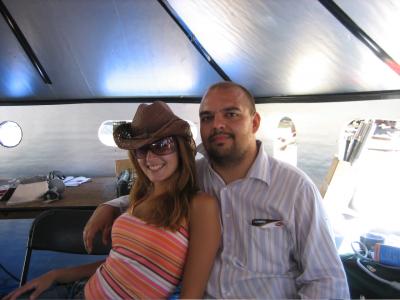
Mr. Gupta inside a hexayurt with Lindsey Darby, a collaborator.
TN: How should people contact you if they are interested in helping out?
VG: hexayurt@gmail.com – people can email me and get me on the phone if they like.

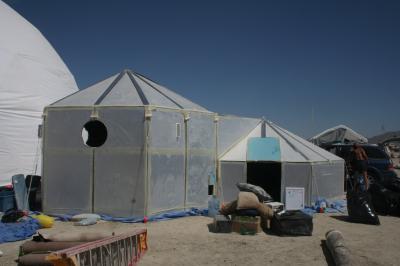

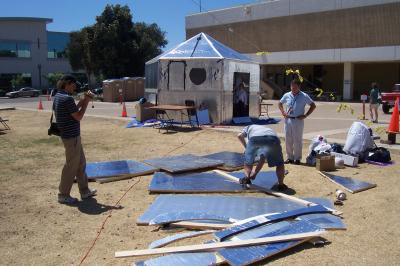
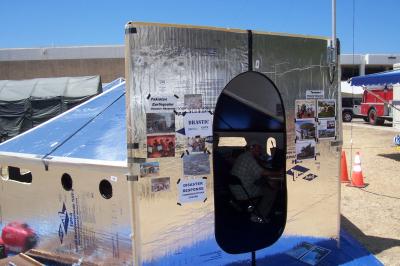
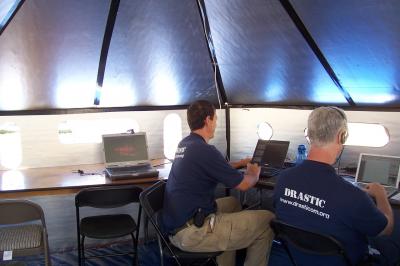
http://www.treehugger.com/files/2007/03/the_hexayurt_ef.php
Is Treehugger on the Hexayurt. I’m answering questions over there too, mebbe we can have a sort of communal Treehugger / Sietch group think!
“Thinking Together” is really one of my keywords for this year: so often you put two smart people in a room together, and their thoughts fit together like pieces of an enormous intellectual puzzle.
Put two million smart people together….
Thinking together.
Thank you *very* much for having me over to chat!
Beautiful article; beautiful idea.
Hi Vinay – Please get in touch with us! I’ve been looking for you since you left Colorado…
looking good mate! Best of luck with everything & drop me a line if you ever get back to the Boston area
Did you ever think that you can actually have fun while playing
with mud. When the ‘counter-culture’ movement was in full swing in the United States in the late 1960s,
many younger people began a ‘back to the earth’ movement in an attempt to draw
a closer connection the land that they instinctively knew sustained them.
No matter where one lives or works it seems like there is always a small patch of soil in need of landscaping attention and maintenance.